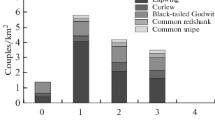Summary
The population of willow grouse (Lagopus lagopus) in the Lower Kolyma district of Yakutia, USSR, shows cycles of abundance with a period of about 10 years. Observations habe been made for 2–5 months each year since 1977. This paper attempts to explain why the period of population depression is so long (3–4 years) and why the peak population density is so high. In “normal” years birds occupied only the 3%–4% of the whole area that consisted of preferred biotope, while during the population peak the less preferred “placour tundra” was also occupied. The most important factor affecting population numbers was the proportion of non-breeding birds, which ranged from 62% in 1981 (population peak) to close to zero in 1979. The high proportion of non-breeding birds in 1980 and 1981 was preceded by deficient winter diets and poor spring nutrition. When the birds arrive at their breeding grounds they defend a territory, which enables them to compensate for winter weight loss and gain condition for breeding. There was a strong negative correlation between territory size and willow biomass density (an index of territory quality). In preferred biotopes birds used only about 8%–12% of resource annually, but the less preferred biotopes were used very intensively. Probably the periodical high peaks and long troughs in willow grouse numbers can be explained as follows. For 2 or 3 years birds can use vast areas with only a low density of suitable food to support reproduction. When these resources are exhausted they take a long time to recover. Meanwhile the grouse population is restricted to patches where with willows abundant, of varying quality, and only a few of them (less than 1% of the total area) may permanently support a high density of willow grouse.
Similar content being viewed by others
References
Andreev AV (1982) Seasonal trends and some features of biology of willow grouse in North-East Asia. In: Lovel TWI (ed) Proc II, Grouse Symp
Andreev AV (1986) Heat flows in nests and energetics of the incubation process in some tundra birds. In: Andreev AV, Kretchmar AV (eds) Experimental methods in northern birds studies and results of their application, Vladivostok pp 84–107 (in Russian)
Andreev AV (1988) Eco-energetics in the arctic chicks. Proc Ornith Soc Moscow (in press) (in Russian)
Dolnik TV, Dolnik VR (1982) Production and productive energy during egglaying period in birds. In: Dolnik VR (ed) Time and energy budgets in free living birds, Proc Zool Inst 113:124–143 (in Russian)
West GC (1968) Bioenergetics of captive willow ptarmigan under natural conditions. Ecology 49:1036–1045
Author information
Authors and Affiliations
Rights and permissions
About this article
Cite this article
Andreev, A. The ten year cycle of the willow grouse of Lower Kolyma. Oecologia 76, 261–267 (1988). https://doi.org/10.1007/BF00379960
Received:
Issue Date:
DOI: https://doi.org/10.1007/BF00379960



